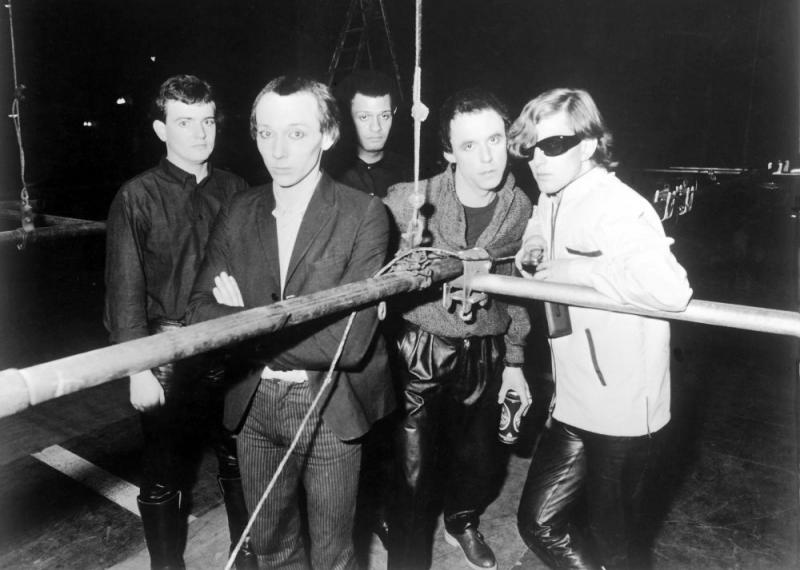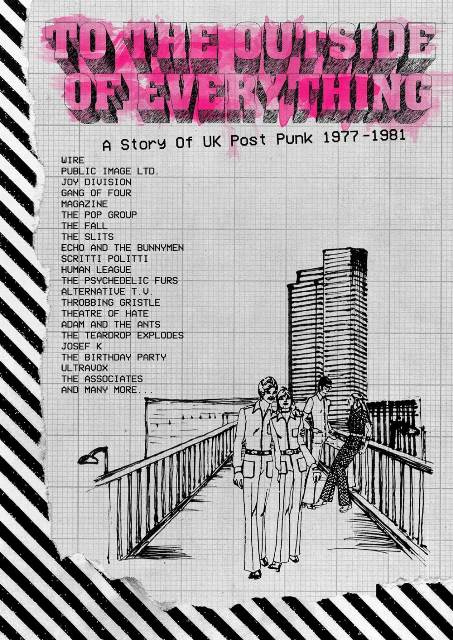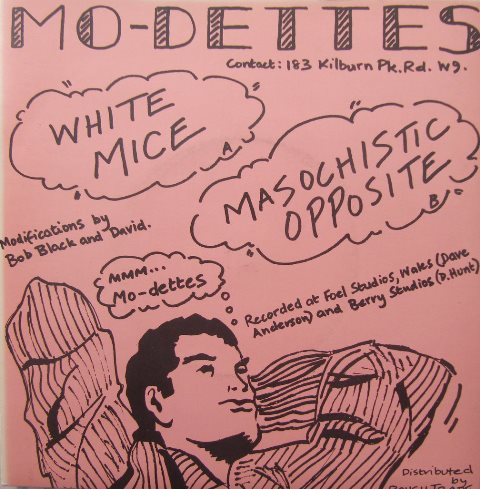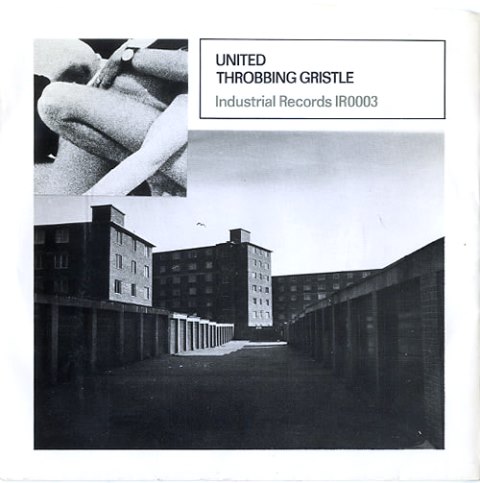Reissue CDs Weekly: To the Outside of Everything | reviews, news & interviews
Reissue CDs Weekly: To the Outside of Everything
Reissue CDs Weekly: To the Outside of Everything
British post-punk gets the box set treatment

Now that the 40th anniversaries of 1976 and 1977 as the years which birthed punk rock have themselves become history, surveyors of rock’s rich tapestry will inevitably turn to what came next. The year 1978 and what followed punk are easy targets and, in terms of labels, post-punk is accepted as a next wave out of the traps.
Proof of the five-CD set To the Outside of Everything's issues grappling with this amorphousness is acknowledged by its non-precise sub-title A Story Of UK Post Punk 1977–1981. There is no one story but, instead, fragmentation and attendant individualism. Goth, new romanticism, oi and Two Tone have as much claim to be post-punk as anything else – all were born or nurse-maided during 1977/78 and had clear ties with 1976/77 punk. But using a chronological designation as a stylistic description is a rocky road. The track-by-track annotation says Sad Lovers & Giants play “a mix of Post Punk and haunting electronic music.” Not even their music can answer the question of what this might mean.
 Nonetheless, a fair wodge of the 113 tracks draw from aesthetic building blocks which surfaced more-and-more during 1977 and 1978: scratchy, trebly funk-styled guitar; strangled or yelping vocals; rubbery bass guitar; dance-music derived or tribal drumming; borrowings from funk, jazz and reggae; the use of primitive electronics to define the nature of the song; lyrics of anomie.
Nonetheless, a fair wodge of the 113 tracks draw from aesthetic building blocks which surfaced more-and-more during 1977 and 1978: scratchy, trebly funk-styled guitar; strangled or yelping vocals; rubbery bass guitar; dance-music derived or tribal drumming; borrowings from funk, jazz and reggae; the use of primitive electronics to define the nature of the song; lyrics of anomie.
The knots tied working out what post-punk is or was are exemplified by Disc One’s opening track. Ultravox!’s “Young Savage” was issued in May 1977. It was the band’s first track to be released which reconfigured the band’s sound to reference punk. They were pre-punk and, especially with their 1978 work, were a major influence on Gary Numan’s Tubeway Army (also included). But seeing them as post-punk? They were, in the lyrics of the collection’s second track and title inspiration “outside of everything.”
That track is Magazine’s “Shot by Both Sides”, the January 1978 debut single from the band formed by Howard Devoto after he left Buzzcocks. It is, as per a lot of what’s collected on To the Outside of Everything, a fantastic record: one of the best ever made. It also – as, to a degree, “Young Savage” had – suggested where the energy and outsider narrative of punk could go next if recontextualised. This outlook defines how To the Outside of Everything is best taken: as a mix-and-match, chronologically sequenced document of punk-inspired individuals pushing forward and the subsequent and inevitable codification of musical tropes.
Amongst those collected who were active in 1977 and swiftly moving on musically were Adam & the Ants, Alternative TV, The Fall, John Lydon (in the form of Public Image Ltd), The Slits, Throbbing Gristle and Wire. Beyond them, most everyone who would be expected is here: including Gang of Four, Josef K, Joy Division, Killing Joke, The Monochrome Set, The Pop Group and Scritti Politti. XTC could be in these run downs but they are absent from the track list.
 To the Outside of Everything is more than a post-punk best-of. Art Objects, The Deep Freeze Mice and Occult Chemistry are not obvious choices due to their relative obscurity. Neither are former Buzzcock Steve Diggle, Mo-Dettes (pictured left, the sleeve of their To the Outside of Everything track "White Mice") and The Normal due to the nature of their music, as they explicitly drew from various pasts in a comparatively unmediated fashion (punk, Sixties pop and Krautrock). It is fascinating to conjure with the musical about-faces executed from what is heard here to generate mainstream success. Take a bow, Scritti Politti and Thompson Twins.
To the Outside of Everything is more than a post-punk best-of. Art Objects, The Deep Freeze Mice and Occult Chemistry are not obvious choices due to their relative obscurity. Neither are former Buzzcock Steve Diggle, Mo-Dettes (pictured left, the sleeve of their To the Outside of Everything track "White Mice") and The Normal due to the nature of their music, as they explicitly drew from various pasts in a comparatively unmediated fashion (punk, Sixties pop and Krautrock). It is fascinating to conjure with the musical about-faces executed from what is heard here to generate mainstream success. Take a bow, Scritti Politti and Thompson Twins.
As is inevitable with genre-type overviews, there are frustrations. Siouxsie & The Banshees, mentioned multiple times in the introductory essay, are missing. So are the important A Certain Ratio and Young Marble Giants. Less critically, the presence of Delta 5, The Lines, The Sound (their precursor outfit Second Layer is included) and The Visitors would have been good. Some of the dance/funk-oriented bands akin to APB would not have been missed and cheeky new wavers The Not Sensibles are a strange inclusion. To the Outside of Everything is a great listen though and unfolds unpredictably – as did the era it covers.
In that spirit, the opening essay makes no attempt to say when “post-punk” was first used (the two words are capitalised and unhyphenated throughout the package’s book). The music weekly Sounds floated the term “New Musick” as something apart from punk in late November 1977 when the writer Jane Suck posited a music which “probably all began with jazz or in the BBC workshop.” Bowie ’s Low, Kraftwerk, Eno, Robert Fripp, Space's synth-disco single “Magic Fly” and The Velvet Underground were her precursors.
 On the same page as Suck's analysis, Jon Savage suggested a raft of emerging bands were unafraid to show their roots. He also identified “harsh urban scrapings/controlled white noise/massively accented drumming.” The paper's ensuing articles were on Devo, Eno, Kraftwerk, The Residents and Throbbing Gristle (pictured right, the sleeve of their To the Outside of Everything track "United"). “New Musick” did not catch on but post-punk would. Hugely amusingly, that same issue of Sounds also included a contrasting retrospective on pub rock, explaining the roots of Elvis Costello, Ian Dury and other recent second and third-wind successes.
On the same page as Suck's analysis, Jon Savage suggested a raft of emerging bands were unafraid to show their roots. He also identified “harsh urban scrapings/controlled white noise/massively accented drumming.” The paper's ensuing articles were on Devo, Eno, Kraftwerk, The Residents and Throbbing Gristle (pictured right, the sleeve of their To the Outside of Everything track "United"). “New Musick” did not catch on but post-punk would. Hugely amusingly, that same issue of Sounds also included a contrasting retrospective on pub rock, explaining the roots of Elvis Costello, Ian Dury and other recent second and third-wind successes.
As to post-punk’s entry point into pop’s lexicon, who knows? Suggestions are welcome. Even Simon Reynolds, in his book Rip it Up and Start Again, did not pinpoint when it was first used.
While To the Outside of Everything is as thought provoking as it ought to be, there are problems which are nothing to do with interpretive viewpoints. Echo & The Bunnymen’s "The Pictures on my Wall” is annotated as the Zoo Records’ single version of the song: it is not, it is the re-recording from their debut album. The Monochrome Set’s “Eine Symphonie Des Grauens” and The Pop Group’s “We Are All Prostitutes” are not the single versions either.
There are frequent temporal mismatches between the pictures of bands in the accompanying book and the tracks included: the image of Theatre of Hate has Bully Duffy in the line-up yet he joined after the track included ("Rebel Without a Brain") and the recording of the ensuing album; the New Order picture is from the “Perfect Kiss” promo video rather than from around the time of “Ceremony”, the track included; a later line-up of Teardrop Explodes is seen to that which recorded “Sleeping Gas”. There are more. Also, amongst the typos: Modern Eon’s album was Fiction Tales not Fictional Tales and the label which issued a Dif Juz cassette was Presently Surprised not Pleasantly Surprise.
Manifestly, To the Outside of Everything is not the definitive statement on the post-punk era. It could not be. Nothing could be, as the sub-title acknowledges. It is, though, a bold, stimulating and frequently thrilling testament to an era when the strictures of genre definitions were shrugged off with aplomb. Niggles about the various slip-ups and the absence of the Banshees and Young Marble Giants aside, it’s hard to imagine it being bettered.
- Next week: Butterfly Child’s 1993 dub/shoegazing album Onomatopoeia
- Read more reissue reviews on theartsdesk
Explore topics
Share this article
The future of Arts Journalism
You can stop theartsdesk.com closing!
We urgently need financing to survive. Our fundraising drive has thus far raised £49,000 but we need to reach £100,000 or we will be forced to close. Please contribute here: https://gofund.me/c3f6033d
And if you can forward this information to anyone who might assist, we’d be grateful.

Subscribe to theartsdesk.com
Thank you for continuing to read our work on theartsdesk.com. For unlimited access to every article in its entirety, including our archive of more than 15,000 pieces, we're asking for £5 per month or £40 per year. We feel it's a very good deal, and hope you do too.
To take a subscription now simply click here.
And if you're looking for that extra gift for a friend or family member, why not treat them to a theartsdesk.com gift subscription?
more New music
 'The Art of Loving': Olivia Dean's vulnerable and intimate second album
Neo soul Londoner's new release outgrows her debut
'The Art of Loving': Olivia Dean's vulnerable and intimate second album
Neo soul Londoner's new release outgrows her debut
 Music Reissues Weekly: The Peanut Butter Conspiracy - The Most Up Till Now
Definitive box-set celebration of the Sixties California hippie-pop band
Music Reissues Weekly: The Peanut Butter Conspiracy - The Most Up Till Now
Definitive box-set celebration of the Sixties California hippie-pop band
 Doja Cat's 'Vie' starts well but soon tails off
While it contains a few goodies, much of the US star's latest album lacks oomph
Doja Cat's 'Vie' starts well but soon tails off
While it contains a few goodies, much of the US star's latest album lacks oomph
 Mariah Carey is still 'Here for It All' after an eight-year break
Schmaltz aplenty but also stunning musicianship from the enduring diva
Mariah Carey is still 'Here for It All' after an eight-year break
Schmaltz aplenty but also stunning musicianship from the enduring diva
 Album: Solar Eyes - Live Freaky! Die Freaky!
Psychedelic indie dance music with a twinkle in its eye
Album: Solar Eyes - Live Freaky! Die Freaky!
Psychedelic indie dance music with a twinkle in its eye
 Album: Night Tapes - portals//polarities
Estonian-voiced, London-based electro-popsters' debut album marks them as one to watch for
Album: Night Tapes - portals//polarities
Estonian-voiced, London-based electro-popsters' debut album marks them as one to watch for
 Album: Mulatu Astatke - Mulatu Plays Mulatu
An album full of life, coinciding with a 'farewell tour'
Album: Mulatu Astatke - Mulatu Plays Mulatu
An album full of life, coinciding with a 'farewell tour'
 Music Reissues Weekly: Sly and the Family Stone - The First Family: Live At Winchester Cathedral 1967
Must-have, first-ever release of the earliest document of the legendary soul outfit
Music Reissues Weekly: Sly and the Family Stone - The First Family: Live At Winchester Cathedral 1967
Must-have, first-ever release of the earliest document of the legendary soul outfit
 Album: Robert Plant - Saving Grace
Mellow delight from former Zep lead
Album: Robert Plant - Saving Grace
Mellow delight from former Zep lead
 Brìghde Chaimbeul, Round Chapel review - enchantment in East London
Inscrutable purveyor of experimental Celtic music summons creepiness and intensity
Brìghde Chaimbeul, Round Chapel review - enchantment in East London
Inscrutable purveyor of experimental Celtic music summons creepiness and intensity
 Album: NewDad - Altar
The hard-gigging trio yearns for old Ireland – and blasts music biz exploitation
Album: NewDad - Altar
The hard-gigging trio yearns for old Ireland – and blasts music biz exploitation
 First Person: Musician ALA.NI on how thoughts of empire and reparation influenced a song
She usually sings about affairs of the heart - 'TIEF' is different, explains the star
First Person: Musician ALA.NI on how thoughts of empire and reparation influenced a song
She usually sings about affairs of the heart - 'TIEF' is different, explains the star

Add comment